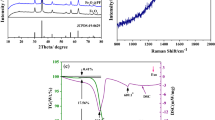Abstract
This paper describes a facile, economical and environment-friendly hydrothermal method of fabricating Fe3O4 and α-Fe2O3 nanoparticles at 180 °C for 12 h, respectively. The as-obtained products were characterized in detail. X-ray powder diffraction and transmission electron microscopy were used to investigate the products’ properties of crystal form, size, and morphology. The results showed the Fe3O4 and α-Fe2O3 nanocrystals’ diameter were about 5 and 20 nm, respectively. Moreover, the electrochemical performances of the Fe3O4 and α-Fe2O3 nanoparticles as anode materials for Li-ion batteries were also evaluated. The first-discharge capacities of Fe3O4 and α-Fe2O3 nanocrystals were 1,380 and 1,280 mAh g−1, and stabled about 96 and 75 mAh g−1 after 20 cycles, respectively. These materials offer substantial promise for developing alternative, high capacity negative electrodes for safer lithium batteries as energy storage and conversion materials.



Similar content being viewed by others
References
Z.L. Gong, Y. Yang, Recent advances in the research of polyanion-type cathode materials for Li-ion batteries. Energy Environ. Sci. 4, 3223–3242 (2011)
P. Poizot, S. Laruelle, S. Grugeon, L. Dupont, J.-M. Tarascon, Nano-sized transition-metal oxides as negative-electrode materials for lithium-ion batteries. Nature 407, 496–499 (2000)
Y. Yu, C.H. Chen, J.L. Shui, S. Xie, Nickel-foam-supported reticular CoO–Li2O composite anode materials for lithium ion batteries. Angew. Chem. Int. Ed. 44, 7085–7089 (2005)
H.B. Wang, Q.M. Pan, J.W. Zhao, G.P. Yin, P.J. Zuo, Fabrication of CuO film with network-like architectures through solution-immersion and their application in lithium ion batteries. J. Power Sour. 167, 206–211 (2007)
H. Kim, D.H. Seo, H. Kim, I. Park, J. Hong et al., Multicoponent effects on the crystal structures and electrochemical properties of spinel-structured M3O4 (M = Fe, Mn, Co) anodes in lithium rechargeable batteries. Chem. Mater. 24, 720–725 (2012)
J.H. Liu, X.W. Liu, Two-dimensional nanoarchitectures for lithium storage. Adv. Mater. 42, 1–6 (2012)
X. Zhang, Y. Niu, Y. Li, X. Hou, Y. Wang et al., Synthesis, optical and magnetic properties of α-Fe2O3 nanoparticles with various shapes. Mater. Lett. 99(15), 111–114 (2013)
M.K. Devaraju, I. Honma, Hydrothermal and solvothermal process towards development of LiMPO4 (M = Fe, Mn) nanomaterials for lithium-ion batteries. Adv. Energy Mater. 2, 284–297 (2012)
G. Xu, F. Li, Z.H. Tao, X. Wei, Y. Liu et al., Monodispersed LiFePO4@C core-shell nanostructures for a high power Li-ion battery cathode. J. Power Sour. 246, 696–702 (2014)
A. Nytén, S. Kamali, L. Häggström, T. Gustafsson, J.O. Thomas, The lithium extraction/insertion mechanism in Li2FeSiO4. J. Mater. Chem. 16, 2266–2272 (2006)
W.M. Zhang, X.L. Wu, J.S. Hu, Y.G. Guo, L.J. Wan, Carbon coated Fe3O4 nanospindles as a superior anode material for lithium-ion batteries. Adv. Funct. Mater. 18, 3941–3946 (2008)
M.V. Reddy, T. Yu, C.H. Sow, Z.X. Shen, C.T. Lim et al., α-Fe2O3 nanoflakes as an anode material for Li-ion batteries. Adv. Funct. Mater. 17, 2792–2799 (2007)
N.A.M. Barakat, Synthesis and characterization of maghemite iron oxide(γ-Fe2O3) nanofibers:novel semiconductor with magnetic feature.J. Mater. Sci. 47, 6237–6245 (2012)
H. Aiping, X. Chen, Y. Tang, L. Yang, H. Xiao, B. Fan, A facile method to synthesize Fe3O4/graphene composites in normal pressure with high rate capacity and cycling stability. Mater. Lett. 91, 315–318 (2013)
P.L. Taberna, S. Mitra, P. Poizot, P. Simon, J.M. Tarascon, High rate capabilities Fe3O4-based Cu nano-architectured electrodes for lithium-ion battery applications. Nat. Mater. 5, 567–573 (2006)
Acknowledgments
This study was supported by National Science Foundation of China (No. 21176061), The Natural Science Foundation of Hunan Province Project (No. 13JJ6084), The construct program of the key discipline in Hunan province of the 12th Five-Year Plan (No. 080502), and The Excellent Engineering Project of the Department of Education of China during the 12th Five-Year Plan (No. 080203).
Author information
Authors and Affiliations
Corresponding author
Rights and permissions
About this article
Cite this article
Lou, X., Huang, J., Li, T. et al. Hydrothermal synthesis of Fe3O4 and α-Fe2O3 nanocrystals as anode electrode materials for rechargeable Li-ion batteries. J Mater Sci: Mater Electron 25, 1193–1196 (2014). https://doi.org/10.1007/s10854-014-1708-6
Received:
Accepted:
Published:
Issue Date:
DOI: https://doi.org/10.1007/s10854-014-1708-6




